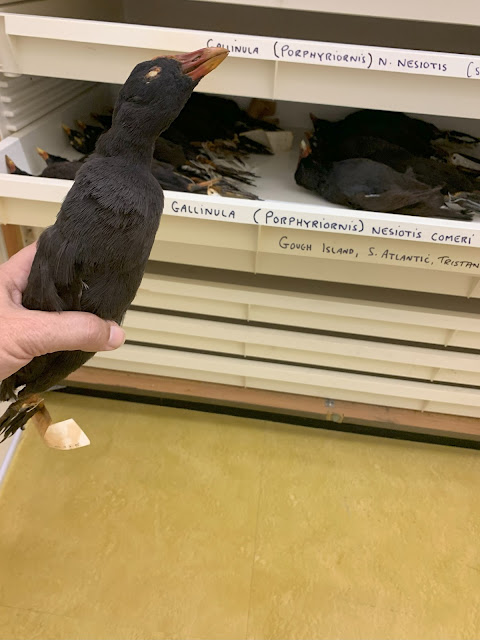Spent the day at Tring today having a look at the Moorhen skins. Here's a few notes on separating American Moorhen and European Moorhen in first-winter plumages in a vagrant context. There is no currently acceptable way of separating these in the field in first-winter so hopefully there are a few ideas/observations here that may be useful and in the right direction. David Sibley has written a couple of articles on separating adults and there is an account in Martin Garner's original Birding Frontiers on the identification of Laughing Moorhen which form the foundation of some of the notes here. Towards the end of this post we have a look at the two Moorhens that we recorded on the Azores this October to see if we can make a call before the DNA results come in.
IDENTIFICATION SUMMARY
First-winter American Moorhen features: Warm brown upperparts (mantle and scapulars) contrastingly strongly with a plumbeous (lead grey) head and neck. The underparts are also grey (and white) lacking the brown tones (mainly in the breast) of European Moorhen. American Moorhen tend to show limited white on the head and throat as opposed to European Moorhen which sometimes has a buff/pale throat set against a brown breast and neck. The bill is longer in American and the frontal shield is more extensive, reaching the top of the eye and is often squared off. The bill colouration on American tends to show less yellow and restricted to a triangle on the bill tip. The tarsus is longer on American Moorhen and overall the bird appears more gallinule like.
First-winter European Moorhen features: Olive-brown upperparts (mantle and scapulars) contrastingly weakly with a brown neck and head. The underparts tend to have brown particularly in the upper breast and overall lack the strongly contrasting and grey underparts and head and neck of American. The bill and frontal shield are smaller, the frontal shield often reaches below the eye and is often rounded unlike the squared off shield of American. Yellow in the bill is often more extensive. The tarsus is shorter and overall the bird is more crake like as opposed to the more gallinule like structure of American Moorhen.
UPPERPART CONTRAST
First-winter American Moorhens (top row) showing warm upperparts contrasting with grey neck and head compared to first-winter European Moorhen (bottom row) with more olive-brown upperparts contrasting less with the browner neck and head
First-winter American Moorhen on right showing strong contrast between upperparts and head and neck compared to less contrasting first-winter European Moorhen on left
As always there are exceptions to the rule- here is a European Moorhen with a contrasting back and neck and head, in this case it looks like an older bird
UNDERPART COLOURATION
First-winter American Moorhens (top three birds) showing grey and white underparts compared to European Moorhen (lower three birds) with brown tones on underparts particularly concentrated on the upper breast
First-winter European Moorhens on left, showing brown and buff tones compared to the more grey first-winter American Moorhens on right with more limited pale on throat and head
FRONTAL SHIELD SIZE AND SHAPE
First-winter European Moorhens showing frontal shield size and shape which tends to be restricted and tapers into a rounded top
First-winter American Moorhens showing frontal shields which are more extensive and squared off on top edge
Again there are exceptions to the rule, here is a European Moorhen with an American Moorhen like frontal shield
BILL SHAPE AND COLOUR
Overall the bill is longer on American Moorhen but there is much overlap. Also there tends to be less yellow in the bill of adult American Moorhen (often confined to a triangle tip) but this is less helpful in young birds which show more yellow in bills when young. First-winter American Moorhens on left and Europeans on right. Also note the overall greyer tones of the American birds and the brown tones on the European birds
THE AZORES BIRDS
Bird one- the warm brown back contrasting with the head and neck, grey tones on the underparts, restricted white to flecking around the face, lack of extensive white on throat, heavy yellow tipped bill already developing and large frontal shield with squared off top (below) all indicate an American Moorhen. If the features suggested in this post can hold under scrutiny it could be possible to identify this bird in the field as an American Moorhen- a first for the Western Palearctic


Bird 2- the olive grey back and lack of strong contrast with the neck and head, the small bill, small rounded shield and white throat all indicate a European bird. We are waiting DNA result on this bird to confirm the identification. It would be strange if an exhausted migrant amidst a huge influx of American vagrants turns out to be a European bird but there is nothing about the plumage or structure of this bird that suggests an American Moorhen. 090124 update- the DNA results have been returned and as suspected was a European bird- results below (thanks to Martin Collinson's lab)
While we are at it......
Couldn't resist having a look at the other species of Moorhen in the collection- here's Dusky Moorhen
Lesser Moorhen
Gough Moorhen
and found the 2007 Portland Allen's Gallinule hiding in the trays too


.jpg)

.jpg)
.jpg)
.jpg)
.jpg)
.jpg)
.jpg)



.jpg)
.jpg)
.jpg)


No comments:
Post a Comment